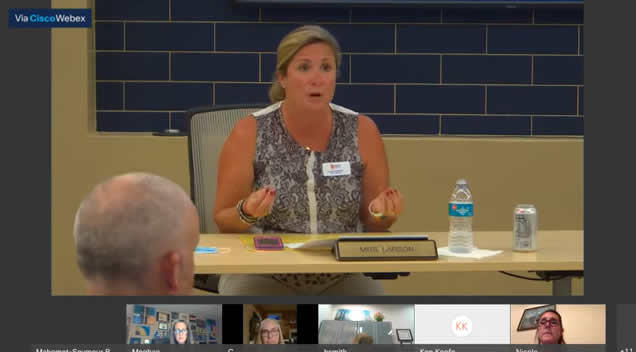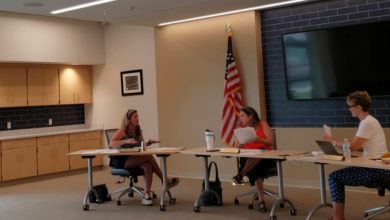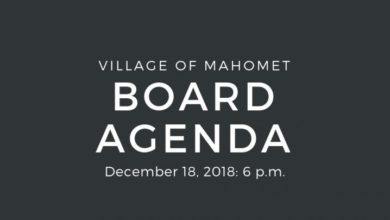Mahomet-Seymour to revisit reopening conversation July 20

The Mahomet-Seymour School board is asking the district’s re-opening task force to come back with a full-day option for the 2020-21 school year.
A July 6 study session to discuss back-to-school options highlighted the work that the Mahomet-Seymour Re-opening task force had completed since May 27. The board discussion looked at the work done by Director of Instruction Nicole Rummel and a teacher subcommittee, including Mahomet Seymour Education Association (MSEA) leadership James Heinold, Meg Jones and Jeremy Davis and between 25-30 teachers representing all grade levels.
The task force recommended, in part, that all students would participate in e-learning on Mondays. Middletown and Lincoln Trail students, grades K-5, would attend half days Tuesday through Friday. Mahomet-Seymour Junior High and Mahomet-Seymour High School students would attend in-person one day a week with e-learning taking place during the other weekdays.
The plan laid out options for students with IEP, RtI and 504 plans to have additional days in school. Plans for families that do not wish to attend in-person are also being worked out.
A second option, one that would be allowable under Illinois State Board of Education guidelines, was also presented. This plan, in part, allowed for K-5 students to attend school all day, every day while staying in an “assigned area within the classroom where they will remain for all learning.”
At the junior high and high school level, students would have e-learning opportunities on Monday, then attend in-person two days a week with off-campus synchronous the other two days.
The task force followed ISBE and CDC guidelines, including face coverings and six-feet social distancing measures, The plans had also been approved by the Champaign-Urbana Public Health Department on June 26, but had not bee run by the district attorney or insurance companies for guidance.
Rummel said that the teacher subcommittee looked at everything from doing learning remotely to having students come back full-time.
“We looked at plans from all the states that had released plans at that time,” Rummel said. “We also looked at several district plans that had come out from various states. Illinois was one of the last states that came out with guidance for their districts.”
Superintendent Lindsey Hall said that she believed the teachers had enough time in between the release of ISBE guidelines and the time the plans were presented to the board to consider how their plans might or could change.
Rummel added that teachers stated that they did not feel comfortable coming back to school full-time until Illinois enters into Phase 5 of the Restore Illinois plan. Gov. JB Pritzker has said that will happen when a vaccine for COVID-19 is available.
Returning to school full-time while the state is in Phase 4 was not something that the subcommittee considered because they did not feel comfortable with it.
A Mahomet-Seymour teacher with underlying health conditions, who wishes to remain anonymous, is worried about contracting COVID-19.
“I’m very afraid of going back and thinking that everything is going to be fine,” the teachers said. “This is a serious thing for me and my family. I can’t give up my pension at this point. I don’t feel like I have an option; whatever the district decides is going to be my fate.”
The teacher understands, though, that there will have to be compromise.
A Monday through Friday all in school option would subject Mahomet-Seymour Junior High and High School teachers to over 100 kids per day, oftentimes in classrooms packed to the brink, which would not allow for social distancing measures.
“I know my in classroom social distancing is not a realistic thing; we have crowding in doorways, crowded hallways, choke points.
“I don’t think that any situation will make me completely safe, but I’d like people to be trying as best they could.
“I would like for the health of teachers and students to be the priority. I’d like all the people who are smarter than me to be thinking about the health of the students and teachers first. There isn’t an ideal solution there’s just the best we can do under the circumstances.”
Rummel said that a child’s attention span in one area also needs to be considered.
“One of the reasons that you saw when we were looking at K-5, in particular, in doing that half day was because we felt that that was probably the max time that a student could stay in their seat for a period of time,” Rummel said.
“We went round-and-round, but (the teachers) kept coming back to the half day because they felt that it was so crucially important that they see those students every day and have face to face interactions with every kid at that level understanding that they are not as self sufficient to be doing activities at home independently. And they felt like if they had half of their class they would still be able to make the gains in reading and writing, and math.”
Rummel said that under the guidelines, teachers would not be able to pull kids to a table for guided reading or small-group instruction.
At Mahomet-Seymour class sizes in the elementary schools can range from 20-25 students at Middletown Prairie to 25-28 students at Lincoln Trail.
“If we all come back full day, every day, I don’t know how to ask a five-year old or six-year old to stay in one seat or one space. Of course we would utilize the outside spaces, but social distancing becomes so much more challenging.”
The document provided to the board stated that it is a “developmentally unrealistic expectation for students to remain in an assigned seat in the classroom for a full instructional day.”
The discussion on e-learning encompassed all grade levels.
Hall said that 2020-21 e-learning would be different from the remote learning that took place when the stay-at-home order came down in mid-March. At that time, instruction was focused on preventing loss of learning. Only two new concepts were introduced in the two month stay-at-home period.
According to ISBE, the district will have to submit an e-learning plan to the State. That plan would include what students would do on Mondays or the half-days that students would be doing e-learning. The combination of e-learning and in-person instruction for all grades would get the district to the required 5 hours of learning required by the State.
The day would be structured in a way where the students would have math, writing and reading in the classroom with reinforced practice math and reading. Students would also have access to a district teacher while working remotely, whether it be a classroom or Encore teacher.
Rummel said that the task force also talked a lot about the need for the e-learning training. The remedy was to take Mondays for professional development where they could be trained on how to provide remote learning to students.
Director of Technology Jared Lynn added that the district was waiting for vision from the board before they equip classrooms with cameras or other equipment that would help teachers broadcast their lessons.
The district did, though, release all of its wifi hotspots during the spring stay-at-home order and equipped buses with wifi to put in spots with limited internet access. Hall said that the district could equip more buses. Rummel added that the plan included a sign-up sheet for students to use the school building for internet access during the day. Lynn added that the district parking lots would also get wifi access for those who wanted to sit in the parking lot to study.
Rummel said that some of the activities outside of classroom instruction would be self-guided reinforcements or students would have access to a teacher. Students may be required to turn in work or the academic online programs are also able to track the student’s activity. The district will also be taking daily attendance.
The district plans to provide a Jump Start program in early August to help students who struggled with remote learning catch up before the school year begins.
Board member Colleen Schultz asked Rummel to clarify that the district’s teachers felt that the two options presented were the best options taking into account how the buildings work. Rummel said yes.
Schultz asked if the teachers had considered other things. She cited “lawyer guidance” that stated that the only time students could take their masks off while inside was to eat lunch. Because most schools do not have enough space to socially distance while students have their mask off, Schultz said that legal counsel noted that most schools will opt to go part time.
During Superintendent Lindsey Hall’s presentation, she said that if the district does go full-time, additional lunch staff would have to be hired. She also said that with half day instruction, there would be increased transportation costs.
“I think that districts everywhere are accepting the fact that COVID-19 is costly, and we have gotten a little bit of help with that through CARES money; we chose to spend that on technology to help support our students, whether it’s on-campus or off-campus learning,” Hall said.
Hall said, for example, that the district will have to spend thousands of dollars on masks.
Board member Meghan Hennesy said that she supports the task force plan. She thought it was well-established with the information and guidelines provided by public health officials at this time.
Board members Jeremy Henrichs, Lori Larson, Max McComb and Merle Giles wanted to see a full, five day a week plan.
McComb said he thought there needed to be options, a remote and full-time option for Mahomet-Seymour students. He said that the district has to be prepared for a remote learning option because if an outbreak happens, whether the state moves to phase 3 or not, the district will need to go back to that model.
“If we don’t prepare for that, we’re not being smart,” McComb said. “We need to be prepared for that in case it has to happen.
“We need to do it relatively seamlessly and we need to do it well.”
McComb also said that the district has a “vested interest in being very careful with and protective” of the staff.
“One thing that has come back through some of the medical guidelines is that not only are kids not typically symptomatic on this, but kids are typically poor carriers,” McComb said. He was backed up by Henrichs.
“I think for our staff, remember you’re working with the least effective carrier. We are hopeful that helps.”
McComb also stated that he believes masks have to be part of the plan, regardless of how much distance is between children or teachers.
“The kids, from what we see, would mostly be fine; probably, mostly asymptomatic. But with the staff that’s not the deal.”
Larson said that a one-day a week option for junior high and high school students was not enough; if the district has to pull back on their plans, that will leave those teens with no in-person instruction.
She was also concerned about the students who did not participate in remote learning in the spring and those who have special needs.
Hennesy added that a one-size fits all approach will not work for the community.
“I think we have to be very cautious about making general statements like most kids are fine. If you are a parent who has a kid with a preexisting condition, that feels very dismissive,” she said.
It has the possibility of making some of our community members feel like they are not being counted in our decision.”
Schultz liked the idea of options, but wanted a hybrid model to be included.
Hennesy said that she would like to see the district provide the community with more information on what the day would look like.
“Without that framework, seeing how we put classrooms together, how many kids we put in a classroom, how we put cohorts together, or if we don’t do that at all, really is going to define how people make decisions about this,” she said. “We have to develop a framework so when we offer people options, they know what they are choosing.”
She added that the taskforce needed to hear from the board if the district was going to vary from the guidance provided by ISBE.
“ISBE guidance) says districts should develop procedures to ensure six foot physical distance from other persons as much as possible,” Hennesy said. “It also has a recommendation that teachers provide assigned seating for students that require students to remain in the seats to the greatest extent possible. So, are we going to tell our task force that our expectation would be that the desks that students sit at are six foot apart. Because if we give them that framework, they can go back and look at the rules that they have and figure out how many kids can actually be in that room with that guidance.”
Henrichs called the ISBE guidelines “fuzzy.” Board member Merle Giles said that they are adapted as more is learned. Henrichs focused on recommendations from the American Academy of Pediatrics as he outlined the need to open school full-time.
The AAP wrote: “Evidence suggests that spacing as close as 3 feet may approach the benefits of 6 feet of space, particularly if students are wearing face coverings and are asymptomatic.”
In contrast, the Centers for Disease Control recommend schools space seating/desks at least 6 feet apart, when feasible.
Since May, the CDC has deemed full-time, full-sized, in-person classes, activities and events would be “highest risk.” The “lowest risk,” the guidelines say, would be for students and teachers to attend virtual-only classes.
This was echoed in an unreleased CDC internal document obtained by the New York Times that was intended to help inform institutions as they stepped back into the learning environment.
The AAP also released a statement with the American Federation of Teachers (AFT), National Education Association (NEA) and AASA, The School Superintendents Association Friday, saying, in part, “Returning to school is important for the healthy development and well-being of children, but we must pursue re-opening in a way that is safe for all students, teachers and staff. Science should drive decision-making on safely reopening schools. Public health agencies must make recommendations based on evidence, not politics. We should leave it to health experts to tell us when the time is best to open up school buildings, and listen to educators and administrators to shape how we do it.
“Local school leaders, public health experts, educators and parents must be at the center of decisions about how and when to reopen schools, taking into account the spread of COVID-19 in their communities and the capacities of school districts to adapt safety protocols to make in-person learning safe and feasible. For instance, schools in areas with high levels of COVID-19 community spread should not be compelled to reopen against the judgment of local experts. A one-size-fits-all approach is not appropriate for return to school decisions.”
While local school district can control what the school day looks like at this point, ISBE confirmed school districts must follow the guidelines: require use of appropriate personal protective equipment (PPE), including face coverings; prohibit more than 50 individuals from gathering in one space; require social distancing be observed, as much as possible; require that schools conduct symptom screenings and temperature checks or require that individuals self-certify that they are free of symptoms before entering school buildings; and require an increase in schoolwide cleaning and disinfection.
Henrichs, a Sports Medicine doctor, said that he believes students would be safe at 3-feet apart, and that teachers are the ones who need to stay 6-feet apart from each other and students.
“The adults, that’s where the risk is,” Henrichs said. “The teachers, amongst themselves and with the students, need to maintain six feet because those are the people who will be high risk.
“The students, I think at three feet would be totally fine.”
Hennesy said that the framework needed to include parents understanding that the teacher would not be able to be within six-feet of their child.
“How often is a teacher within six feet of the child when they’re teaching?” Henrichs asked.
“I think pretty often,” Hennesy said.
“I don’t think so,” Henrichs replied. “I mean, maybe for people who are in special education classes, but I think in a normal classroom, the teachers are not on top of their students.
“We also have to keep in mind that physical health is definitely important but that social, emotional developmental health of our students is also part of the whole person. We can’t just take one part of the person and say well this is what’s best for this group of people,” Henrichs said.
Henrichs called on the community to make school work for the 2020-21 school year.
“If you own a tent company, we need your tents. If you have a bunch of space heaters you need your space heaters to keep kids warm in the winter. If you own a construction company that provides outdoor space for us, then we’re going to need that. We’re going to need everybody in this community to get on board to help our students to make that work. It’s going to take a team effort.”
Keefe echoed that he would like the taskforce to consider organizations in the community: Mahomet Area Youth Club, churches, the M-S PTO, that the district could use to collaborate on solutions for the school year.
“I think that they will step up to the challenge and this community can handle it.”
Henrichs said that he wants the community to keep in mind that phase five, a return to schools and businesses being open, does not happen until there is a vaccine.
“There’s no guarantee that we’re gonna have a vaccine,” he said. “And so then we have to start thinking about how are we going to educate our students over a period of years, and not just over a period of weeks or months.
“I don’t think we can put it in the context of we’re going to have the vaccine and everything’s going to be fine. We have to look at this as a long term long-range perspective.
“And the other question is, who do we serve? We serve our students and our families. So absolutely, we need to hear from them and know what they desire in this as well. But our purpose is to educate them. And the best education is in person.
“We can still offer a remote option for people to do that if they desire, to take that option instead of in person we’re not forcing anybody to go to school every day. There’s a choice. You can go. Or you can not go. And we’re going to do our best to serve them in both environments.”
Henrichs said that the district should come up with options, allow parents to pick which option they would like, then, “they’re going to have to trust us for the details.”
Schultz, an Economics Professor at the University of Illinois who teaches a statistics course, said that she is interested in hearing from the public, but wanted to make sure that the right questions were asked.
“When we’re counting up the number of people that are writing into us, I think one of the things that we need to really be careful about is that we understand the self-selection bias. Because if, because we did not ask people to give us feedback. We had a plan that was in our board packet, and people read it and just because of the nature of human nature, people are more apt to comment if they disagreed with what was in there. And so, while it might be that a majority of our parents disagree, it also might be there’s a bunch that agree that didn’t right because they read it and said well that sounds good to me.”
At the time, the board had received letters from about 90 constituents. Those letters have been published on the district’s website. Hall said that those received after the board meeting would not be published in the same manner because “the remainder of the emails we received weren’t indicated to be for public comment.”
A FOIA request for the rest of the letters has been submitted to the district. Another piece about community feedback will be written when those have been received.
Prior to the July 20 board meeting where a decision will be made on how to move forward, Hennesy asked the district to consult with their insurance company and lawyers to see if going against ISBE, IDPH and CDC guidance will do damage to the district.
“I don’t think the changes are necessarily over either in terms of the guidance that we receive and some of the different decisions that could be made in the next couple of weeks,” Hall said. “I know it’s a super uncomfortable, really scratchy hard place to be with uncertainty, and everything constantly changing. I don’t think that’s going away for a long time. I’d like to have certain plan to know exactly how it’s going to play out, but I couldn’t tell you what we’re going to be doing in November, December.”
Part of the board wanted the district to consider how many people would not come back if there was a full time option. Another part of the board wanted the district to consider how many people would not come back if there wasn’t an alternative options.
The Mahomet-Seymour School Board will meet to discuss this topic on July 20 at 7 p.m. at Middletown Prairie Elementary during their regularly scheduled board meeting.




